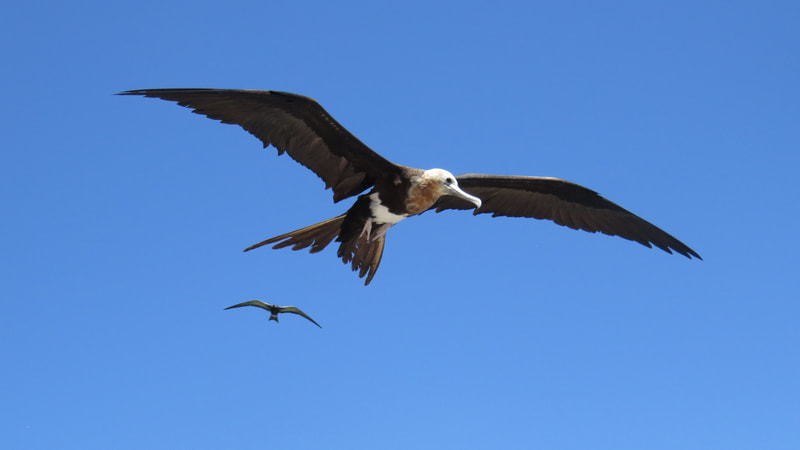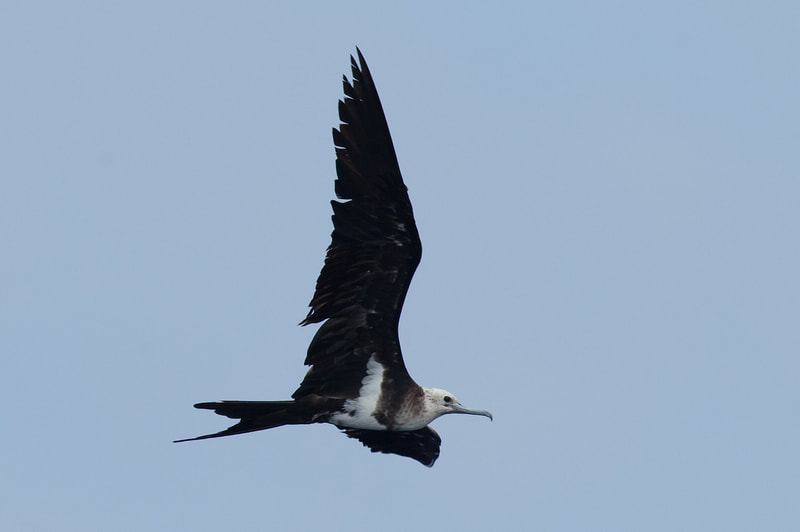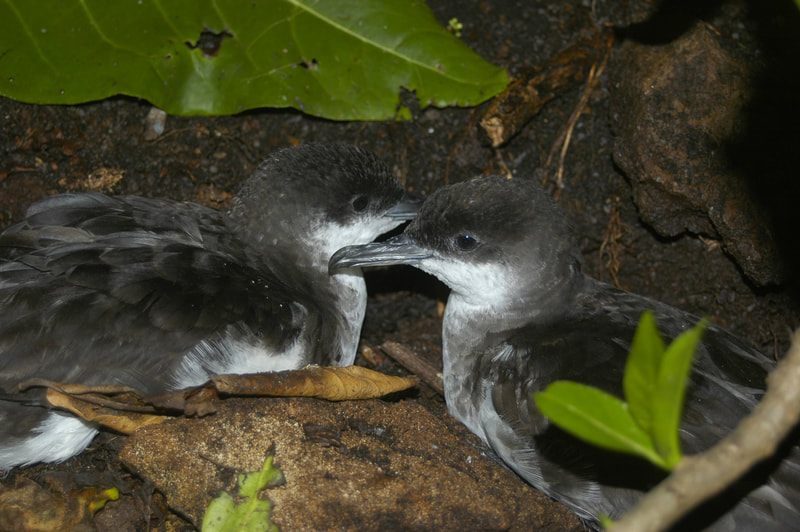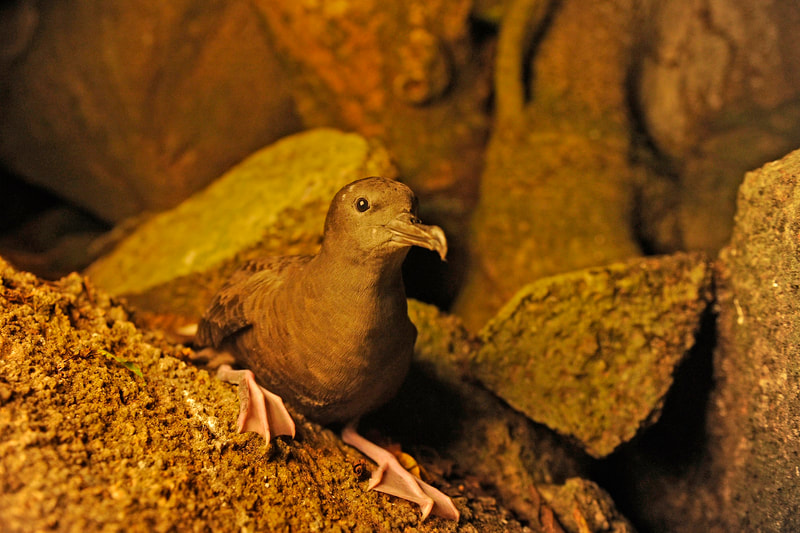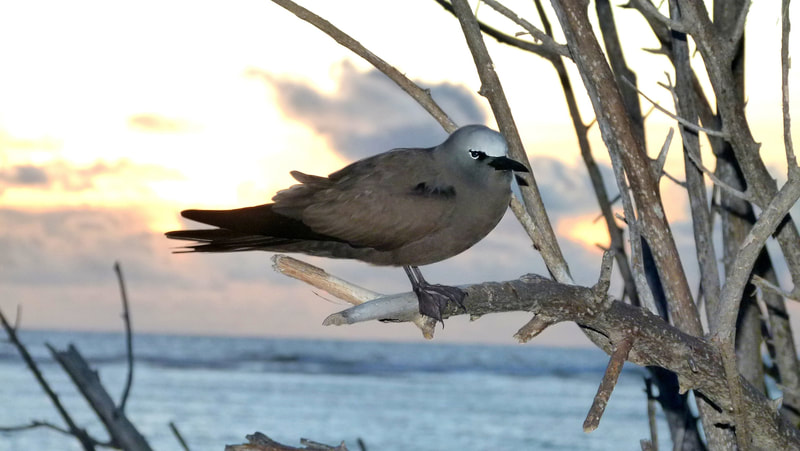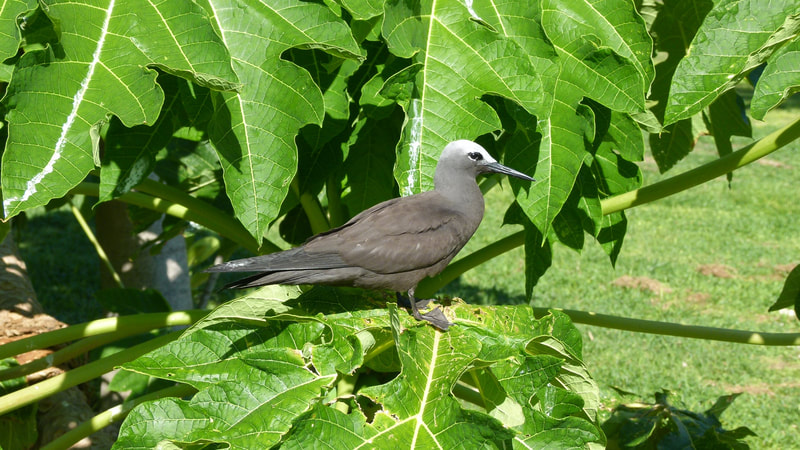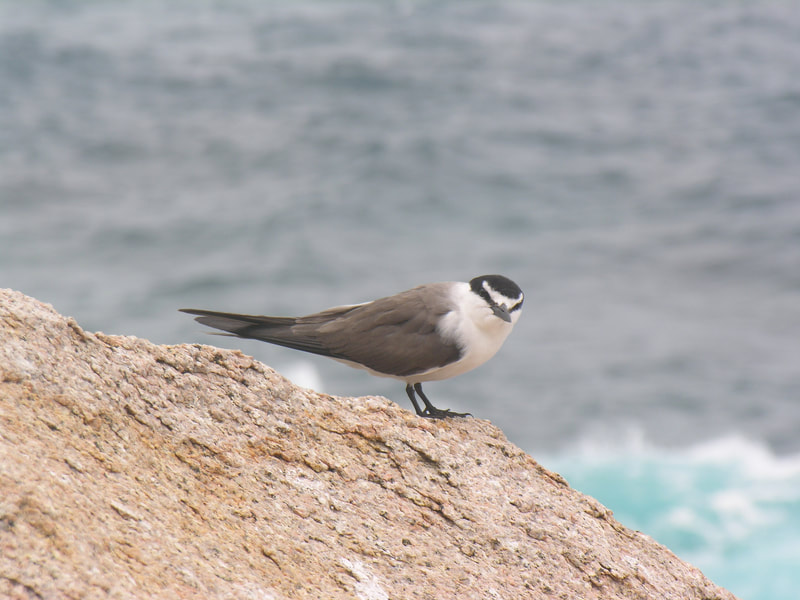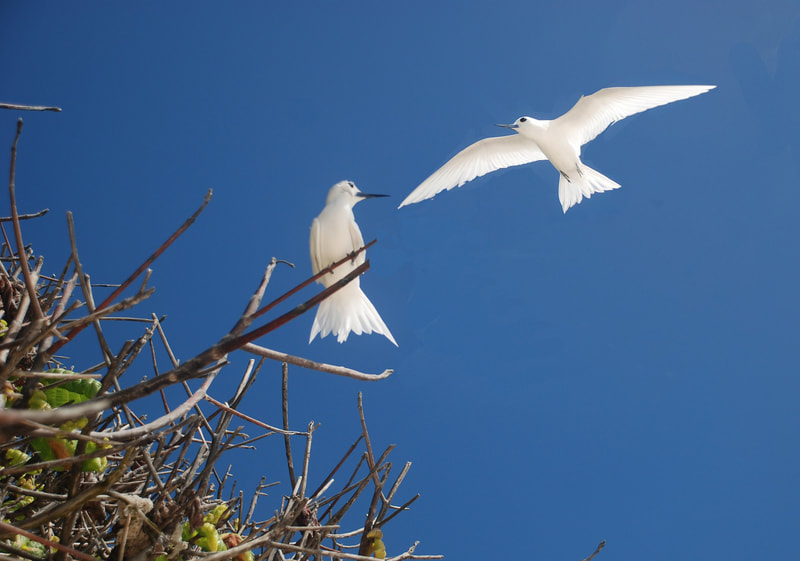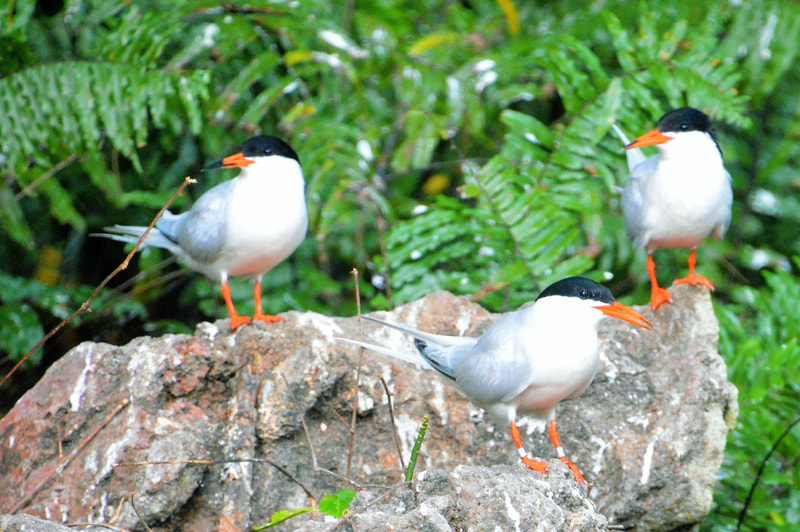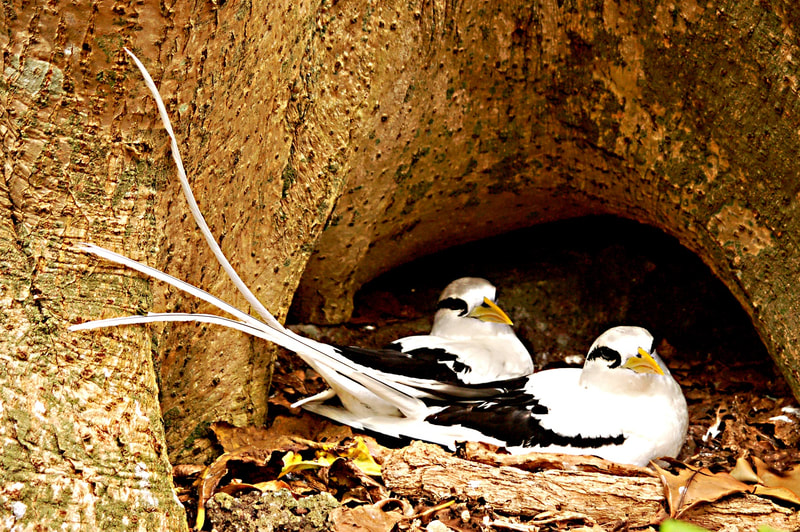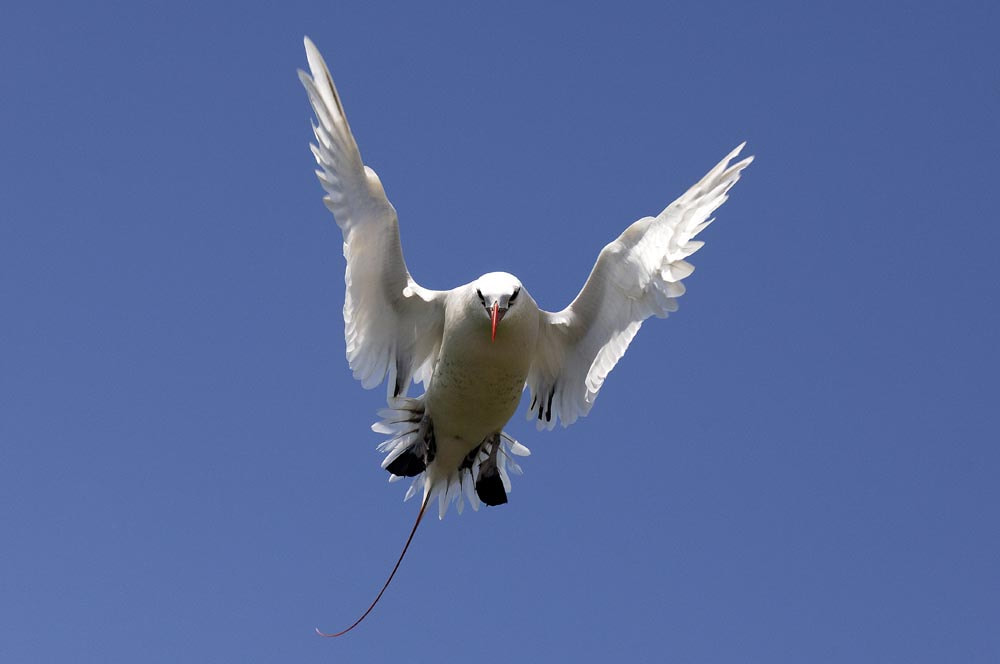Seabirds
Ten species of seabird have been recorded breeding at Aride (mainly at the plateau and hillside woodland habitats), more than at any other Seychelles island, including the world’s largest colonies of two species. In addition, huge numbers of two non-breeding frigatebird species may be seen all year-round, especially at the hilltop, the largest frigatebird roost of the granitic islands.
Frigatebirds
Great Frigatebird Fregata minor (above left) is by far the more common of the two frigatebird species to be seen at Aride. The island holds the largest roost in the granitic islands. This species is most easily identified by its all-black underwing, whereas in Lesser, white spurs extend to the underwing. Lesser Frigatebird F. ariel (above right) is also somewhat smaller than Great Frigatebird, but this is difficult to assess in natural conditions. Both species breed at Aldabra. Small numbers of Great Frigatebird also breed at Cosmoledo. Most Aride birds are immature; breeding males, which have a bright red inflatable gular sac are rarely seen. Frigatebirds will attack other seabirds to force them to drop their catch or take their own prey on the wing.
DID YOU KNOW?
Males and female frigatebirds have very different plumages, a very rare feature in seabirds. In avian history, this is a relatively recent trait to appear, despite frigatebirds seemingly primitive appearance. No birds take longer to reach maturity than the frigatebirds: they do not breed until 10-12 years of age. Frigatebirds have the longest breeding cycle of any bird, a full 12 months, taking a year or more off between successful breeding attempts.
Frigatebirds are unable to land on the surface of the water because they have small, unwebbed feet that do not give them sufficient thrust to take off again and in addition, their plumage is not waterproof. However, they are maestros of flight. Unlike any other group of birds, the pectoral girdle bones are fused together, acting like a rudder and giving great strength and agility in the air. They have the lowest wing-load factor (ratio of total weight to wing area) of any bird. They are surprisingly light (only 600-1,600g), with pneumatic flexible bones that make up just 5% of their weight: another record, being less than any other bird.
DID YOU KNOW?
Males and female frigatebirds have very different plumages, a very rare feature in seabirds. In avian history, this is a relatively recent trait to appear, despite frigatebirds seemingly primitive appearance. No birds take longer to reach maturity than the frigatebirds: they do not breed until 10-12 years of age. Frigatebirds have the longest breeding cycle of any bird, a full 12 months, taking a year or more off between successful breeding attempts.
Frigatebirds are unable to land on the surface of the water because they have small, unwebbed feet that do not give them sufficient thrust to take off again and in addition, their plumage is not waterproof. However, they are maestros of flight. Unlike any other group of birds, the pectoral girdle bones are fused together, acting like a rudder and giving great strength and agility in the air. They have the lowest wing-load factor (ratio of total weight to wing area) of any bird. They are surprisingly light (only 600-1,600g), with pneumatic flexible bones that make up just 5% of their weight: another record, being less than any other bird.
Shearwaters
|
Tropical Shearwater Puffinus bailloni is the only small and only black-and-white shearwater breeding in Seychelles. It breeds year-round mainly on rat-free islands, but it is rare west of Mahe. Aride may hold the largest colony in the world. Birds depart before dawn and at sunset they return from their feeding forays at sea, emitting strange eerie calls. The Creole name was first cited by Oustalet (1878), as fouquet riga. It has historically been Creole name Riga may recall the cry of the bird from rire, French for ‘to laugh’, the strange calls also being evocative of laughter. Shearwaters struggle to take to the air from their woodland nest sites, so shortly before dawn, Tropical Shearwaters climb up boulders and tree trunks to gain height prior to lift-off.
|
Wedge-tailed Shearwater Ardenna pacifica is the only large shearwater and only all-dark shearwater breeding in Seychelles. It breeds throughout the Indo-Pacific, including the granitic islands of Seychelles and the Amirantes. Birds may breed in any month, but there is a general pattern of prospecting for burrows in August, laying in September, with chicks from December to February. Shearwaters are members of the ‘tubenoses’ that use a glandular structure over their bill to allow them to secrete salt after drinking seawater. Birds return to breeding burrows at Aride at night and depart before dawn. The Creole name is Fouke-de-Zil is derived from the French fouquet, a term used by French sailors for petrels dating back to 1689.
|
DID YOU KNOW?
Research by Island Conservation Society at Aride using GPS devices to track movements show that birds often travel up to 150 kilometres from Aride to feed at the eastern edge of the Seychelles Bank.
Research by Island Conservation Society at Aride using GPS devices to track movements show that birds often travel up to 150 kilometres from Aride to feed at the eastern edge of the Seychelles Bank.
Terns - Noddies
Brown Noddy Anous stolidus (above left) is a robust all-dark brown tern with a whitish cap. The adult has a greyish-white forehead and crown sharply defined in front of the eye, unlike the smaller Lesser Noddy A. tenuirostris (above right) is a lighter all-dark tern, the grey crown and nape merging evenly at the lore giving a gentler appearance. The bill is finer and proportionately longer than Brown Noddy.. They are among the most common seabirds of Seychelles.
The Creole name of Brown Noddy is Makwa is said to have been derived from the dark colour of the plumage for this bird, similar to the African Macoa race. Slaves of this race were brought from Mozambique to the Mascarenes in the 18th Century. Local names of Lesser Noddy include Kelek and the Creole expression la mon’n kelek, is sometimes used meaning 'I'm famished'.
DID YOU KNOW?
Aride is home to the world's largest colony of Lesser Noddy. The English name ‘noddy’ refers to the courtship displays of these birds, in which they nod their heads to each other.
The Creole name of Brown Noddy is Makwa is said to have been derived from the dark colour of the plumage for this bird, similar to the African Macoa race. Slaves of this race were brought from Mozambique to the Mascarenes in the 18th Century. Local names of Lesser Noddy include Kelek and the Creole expression la mon’n kelek, is sometimes used meaning 'I'm famished'.
DID YOU KNOW?
Aride is home to the world's largest colony of Lesser Noddy. The English name ‘noddy’ refers to the courtship displays of these birds, in which they nod their heads to each other.
Terns - Onychoprion
Sooty Tern Onychoprion fuscatus (above right) breeds in Seychelles in larger numbers than any other bird. It is a fairly large mainly black-and-white tern with long tail streamers. Colonies are very noisy places day and night. Birds are present at Aride mainly in March to October and this is the largest colony of the granitics. Sooty Tern eggs are still collected for consumption. The Aride colony is protected by law but suffers from poaching. Bridled Tern O. anaethetus (above left) is a smaller version of the Sooty Tern, paler browner and less uniform above than Sooty and shorter-winged. At close range, the white forehead extends behind the eye as a narrow white supercilium emphasising the black line through the eye and a black stripe continues to the gape with even width. The Creole name is Fansen and the local expression parey fansen lo labour koko (like a Bridled Tern on a coconut husk) means someone holding onto a treasured possession (it is often seen perched on objects at sea such as a floating coconut).
DID YOU KNOW?
Remarkably, Bridled Tern breeds in an 8-month cycle at Aride and elsewhere in Seychelles, whereas in other parts of the world it has an annual cycle.
Geolocators and satellite tracking of birds has revealed the long journeys made by Sooty Terns outside the breeding season, some even visiting the western borders of the Pacific Ocean. in 1995, a Sooty Tern arrived to breed on Aride that had been ringed as a chick on Kermadec Islands, New Zealand in 1961 (a distance of 13,350km from Aride).
DID YOU KNOW?
Remarkably, Bridled Tern breeds in an 8-month cycle at Aride and elsewhere in Seychelles, whereas in other parts of the world it has an annual cycle.
Geolocators and satellite tracking of birds has revealed the long journeys made by Sooty Terns outside the breeding season, some even visiting the western borders of the Pacific Ocean. in 1995, a Sooty Tern arrived to breed on Aride that had been ringed as a chick on Kermadec Islands, New Zealand in 1961 (a distance of 13,350km from Aride).
Terns - Others
|
Fairy Tern Gygis alba is the world’s only all-white tern. It breeds year round at Aride, but it much prefers the northwest monsoon, when the breeding numbers may be three times higher than the opposite time of year. It is famous for its extraordinary habit of laying its single egg on a bare branch. This incredible balancing act is achieved by utilising the more horizontal branches of trees or laying the egg at a notch or fork to provide support. Birds often fly in pairs, twisting and turning, sometimes hovering
|
Roseate Tern Sterna dougallii arideensis is present at Aride for a shorter period than any other breeding bird, arriving in late April and departing by the end of August. This is one of the most elegant of seabirds, pale grey above, white below with long tail streamers. The underparts develop a rosy hue when breeding and the long slender bill turns from black to red. They are unlikely to be confused with any other species; no other similar tern is present during the breeding season.
|
DID YOU KNOW?
Fairy Tern was effectively first named by Charles Darwin. In Voyage of the Beagle he remarks, "There is one charming bird: it is a small, snow-white tern, which smoothly hovers at the distance of a few feet above one's head, its large black eye scanning, with quiet curiosity, your expression. Little imagination is required to fancy that so light and delicate a body must be tenanted by some wandering fairy spirit..."
Clearly, this was a Fairy Tern.
Fairy Tern was effectively first named by Charles Darwin. In Voyage of the Beagle he remarks, "There is one charming bird: it is a small, snow-white tern, which smoothly hovers at the distance of a few feet above one's head, its large black eye scanning, with quiet curiosity, your expression. Little imagination is required to fancy that so light and delicate a body must be tenanted by some wandering fairy spirit..."
Clearly, this was a Fairy Tern.
DID YOU KNOW?
Taxonomy is uncertain, but if recognised, the race of Roseate Tern present in Seychelles is named arideensis, after Aride. Geographical variation in races mainly involves bill colour and arideensis has the least amount of black on the bill of any race during the breeding season, supporting recognition. It was once more common and widespread. The protection of Aride is vital to its survival in Seychelles.
Taxonomy is uncertain, but if recognised, the race of Roseate Tern present in Seychelles is named arideensis, after Aride. Geographical variation in races mainly involves bill colour and arideensis has the least amount of black on the bill of any race during the breeding season, supporting recognition. It was once more common and widespread. The protection of Aride is vital to its survival in Seychelles.
Tropicbirds
|
White-tailed Tropicbird Phaethon lepturus is one of the world’s most elegant seabirds, mainly white with a black diagonal wing-bar, black wing tips, long white tail-streamers and a yellow bill. Birds breed year-round on rat-free islands such as Aride. They are strong fliers, diving to take fish and squid or even catching flying fish in flight. The white stiletto-like shapes are unforgettable against a clean blue sky. Pairs mate for life and may breed at any time of year. Studies on Aride indicate a mean interval between successful breeding attempts of nine months.
|
Red-tailed Tropicbird P. rubricauda is a relatively heavy tropicbird, with broad wings and a bright red bill. The thin, red tail plumes are not visible at range, giving the bird an all-white appearance. The bill is red unlike White-tailed Tropicbird. Birds are rarely seen at Aride, although a small colony on the northern cliffs of the island is the only breeding site recorded in the granitic group. They breed year-round but mainly January to April. However, there are no recent records on Aride and it is possible they struggle to combat the piratical frigatebirds that inhabit their breeding cliffs.
|
DID YOU KNOW?
Genetic evidence shows tropicbirds are an ancient lineage. Their placement within the avian tree remains uncertain but somewhat bizarrely, they are placed tentatively closest to the Kagu Rhynochetos jubatus endemic to New Caledonia and Sunbittern Eurypyga helias of Tropical America.
Genetic evidence shows tropicbirds are an ancient lineage. Their placement within the avian tree remains uncertain but somewhat bizarrely, they are placed tentatively closest to the Kagu Rhynochetos jubatus endemic to New Caledonia and Sunbittern Eurypyga helias of Tropical America.
